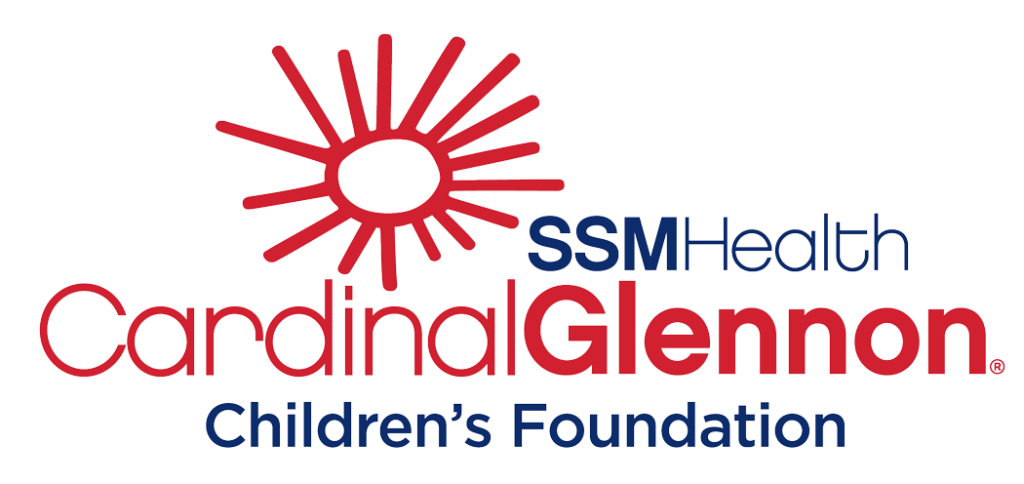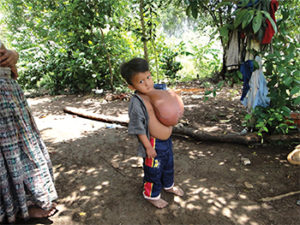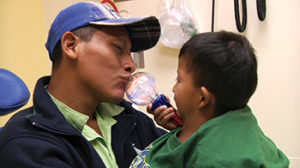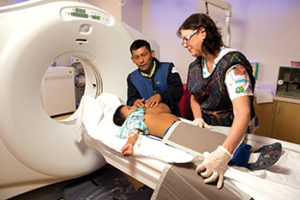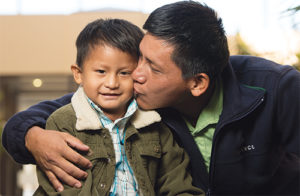Our Patients:
Angel Caac Cal
![angel[1] angel[1]](https://www.glennon.org/wp-content/uploads/sites/12/2019/05/angel1.jpg)
In sports terms, “It was bigger than a soccer ball but not quite the size of a basketball,” says John Stith, M.D., an otolaryngologist at SSM Health Cardinal Glennon Children’s Hospital. “I have seen this type of mass only a handful of times in my career. I have never seen one this large. It’s amazing that he managed to live with it and thrive in spite of it.”
The swinging weight of the tumor prevented Angel (pronounced AHN-hel) from active play. He slept on his side so the mass would not press on his chest. He waddled when he walked and had to hold “the ball” so he could maintain his balance. He preferred to be carried by his father.
“I had never seen anything like it,” adds Dary Costa, M.D., another SSM Health Cardinal Glennon otolaryngologist who was lead surgeon on the case. “If Angel had been born in the United States, the mass would have likely been removed when it was still small in size. Usually neck masses in children are recognized when they are less than an inch in diameter.”
The tumor was beginning to harm Angel’s self-image.
“Having a large tumor hanging off the neck is a significant detriment, especially for a child,” Costa says. “Angel was cognizant of it. Age 5 is right when children start to recognize differences in their appearance. The fact that we could make him look normal was important.”
More important was the tumor’s likely impact on Angel’s life span.
“The tumor would have slowly gotten larger and increasingly symptomatic, stretching adjacent structures until it outgrew its blood supply,” Costa says. “Parts of it may have started to die and cause infection that could spread to his bloodstream and end his life. It is difficult to say how long that would have taken.”
The highlands of Guatemala
Angel was brought to St. Louis by the World Pediatric Project, a charity that links pediatric surgical and medical providers with critically-ill children in developing countries that do not have advanced health care resources.
“We first heard about Angel at the end of last year. When we saw that picture, we knew we needed to help that little boy,” says Kate Corbett, senior program director of the World Pediatric Project’s St. Louis branch.
“We have partners in Central America and the Caribbean who refer children to us,” Corbett says. “We also have medical teams that travel to our partner countries and find children whose surgical needs are too complicated for them to be treated there.”
Guatemala sits just south of Mexico and spans Central America from the Pacific Ocean to the Caribbean Sea. Angel lives in the highland city of Chisec in the department, or state, of Alta Verapaz. Nearly all of Chisec’s 70,000 people are descended from the Mayan civilization that thrived throughout Central America from about 250 B.C. to 950 A.D.
Spanish is Guatemala’s official language but Chisec’s common dialect is Q’eqchi, one of 21 Mayan dialects still spoken. It is named for the Q’eqchi people who were part of the Mayan empire and now comprise six percent of the country’s population.
More than half of Guatemala’s population is classified as living in poverty. Mayan regions of Guatemala also have few health care resources due to remoteness and the preferences of some residents for care from traditional, indigenous healers.
“Kate contacted me and asked if we might take care of Angel,” Stith says. “There are parts of the world where the medical care is very poor compared to what we have here. We like to help them. It is nice to transfer what we have to help other people. It is a call to service.”
The surgeons volunteered their services. Support also was pledged by SSM Health Cardinal Glennon, the SSM Health Cardinal Glennon Children’s Foundation and Saint Louis University School of Medicine. The World Pediatric Project began making travel arrangements.
Angel and his father, Jose, landed in St. Louis last January with their pastor, Victoriano Pop Ho, who could translate Q’eqchi into Spanish for an interpreter who spoke English for caregivers. Left behind were Angel’s mother, Ofelia, and three older sisters.
“Angel was born healthy,” says his father, a short, trim and muscular man who farms corn and beans. “When he was about a year and eight months old we noticed he had a small growth coming out of his neck. We saw some doctors to see what they could do. No one would operate on it and it kept growing and growing. A friend working with an oil company connected us to come here.”
The growing tumor was accompanied by fevers, Jose says. “It was so heavy it was difficult for him to walk or take part in regular kid activities. It also made it hard for him to sleep. It was a lot for him to deal with.”
After Angel arrived at SSM Health Cardinal Glennon, his doctors tackled the mystery of the tumor’s diagnosis. “We wanted to have as much pre-evaluation done in Guatemala as possible since we really didn’t know what the mass was,” Stith says.
Two possibilities were suggested by doctors in Guatemala. First was teratoma, an embryonic tumor containing muscle, hair and even teeth. Second was another congenital growth, a thyroglossal duct cyst arising from the thyroid gland. Both would have posed difficult surgical challenges.
“We were very skeptical about that diagnosis. We had never seen a thyroglossal duct cyst of this proportion. When we saw the MRI we knew it wasn’t that,” Stith says.
Imaging conducted at SSM Health Cardinal Glennon identified a probable benign tumor attached to the sternocleidomastoid muscle. Consisting largely of connective tissue and blood vessels, it offered better potential for a good outcome. Later histopathologic examination of the specimen reported a mesenchymal tumor.
However, Angel’s mesenchymal tumor was very, very large.
“The surgery took about six hours,” says Costa, an assistant professor of pediatric otolaryngology at Saint Louis University School of Medicine. “It was very extensive. It required myself and Dr. Stith and several resident team members. We needed several sets of hands to help hold the mass in position while we were carefully separating it from the normal structures. It was attached to the large draining vein of the neck, the jugular vein, and also to the soft tissue over the larynx, the thyroid gland and the hyoid gland.
“We made an incision and slowly separated it from the normal structures of the neck. There were several large blood vessels going into the tumor that we had to carefully navigate to avoid the loss of too much blood. Then we had to carefully close the skin, because the skin had been stretched by the tumor’s growth. A fair amount of the skin had to be removed.”
“The surgery was fairly uncomplicated because it was not a teratoma. From my perspective the uniquely difficult feat in the procedure was manually holding up the tumor to avoid contaminating the surgical incision, while the neck was being prepped with antiseptic solution, and manipulating it during the course of the resection,” says Stith, an associate professor of otolaryngology at Saint Louis University School of Medicine.
Angel’s case provided an unusual training opportunity for the medical center’s staff and students, he adds. “These can be terrible problems that maybe we wouldn’t otherwise see in the United States. Taking care of them is an interesting experience and good for our professional development.”
A fiesta for Angel
The heart-breaking little boy who entered the operating room emerged as a handsome young man. Tears rolled down Jose’s face when he was admitted to Angel’s recovery room.
“He looked great,” Jose says through the Q’eqchi and Spanish interpreters. “He had a little bit of difficulty post-op due to pain, but since then he has been a lot happier because he doesn’t have that extra weight on him. He is able to have more fun and be a happier kid.
“The surgeon gave us the good news that we shouldn’t have any more issues with the tumor. Nothing should grow back. The only thing that is going to linger will be the scar from the surgery, but that is not an issue for us.”
“By the end of his hospital stay he was walking and maintaining his balance much better. He was playing and seeming to feel better,” Costa says. “To be able to do one short procedure that made his life so much better — this is what keeps me going every day.”
Heading home
Three weeks after Angel, Jose and Victoriano arrived in St. Louis, they headed home. Jose carried a book of photographs.
“We want to remind him of his trip to the U.S. and what he came for and how St. Louis changed his life,” Jose says. “Before we came to St. Louis he played a little bit with his toys but tired easily. I have noticed that he has started playing a lot more with his little cars and teddy bears.
“I would really like to thank everyone who was involved with Angel’s treatment and made it possible for us to come here. We are thankful to the World Pediatric Project for transporting us to and from the hospital. We would like to thank all the volunteers who visited us and the Ronald McDonald House for keeping us and providing food and clothing. We also are very grateful to the Cardinal Glennon Children’s Hospital team for everything they have done for us.”
A world partnership
“Angel exemplifies the beauty of our partnership with Cardinal Glennon,” says Corbett. “We have the expertise and compassion of Cardinal Glennon’s physicians and hospital. Cardinal Glennon opens its arms to these children so parents like Jose and Ofelia can have their dreams come true.
“Then we have the expertise of the World Pediatric Project, which knows how to navigate to get these children here and support them while they are in the United States. These two partners enabled a boy like Angel to get back to the business of being a normal kid. He will lead a normal life and have a beautiful future ahead of him.”
“Many blessings”
Angel and his father were excited about returning to their family’s arms.
“My wife was very sad when we left to come to St. Louis,” Jose says. “Now she is looking forward to welcoming us home. She is so happy to know that Angel can now lead a normal life. We are excited to see our family and have them rejoice with us.”
Angel’s village celebrated his return with a fiesta. Jose sent back pictures.
“A lot of people came out,” Stith says. “We could see that Angel looked great and was a very happy child. Whenever we can help someone in need and see that they are appreciative, it does give us good feelings.”
“In our village, kids start school when they are six years old, so Angel will start kindergarten next year,” Jose says. “He also is looking forward to learning how to ride a bicycle.
“We appreciate all of you and we wish many blessings to you.”
